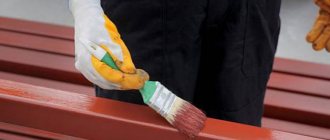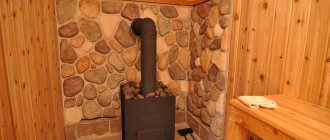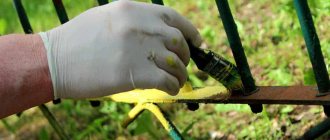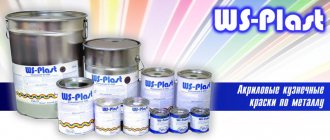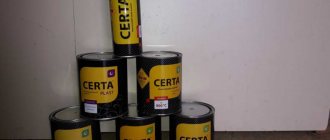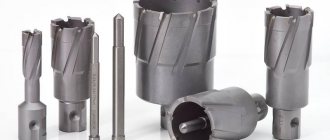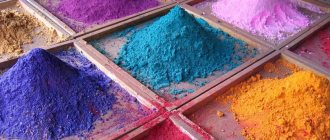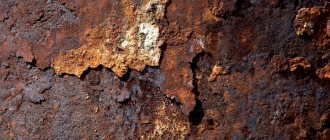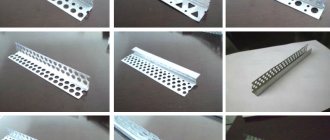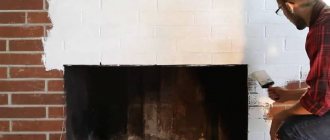To protect radiators, pipes, metal stoves and other elements of the heating circuit from initial manifestations of corrosion and further active rusting, it is necessary to apply and renew the coating. For this purpose, heat-resistant paint for metal up to 1000 degrees is used. It's not easy to choose. Do you agree?
In addition to protective functions, it also has purely aesthetic responsibilities. The use of a heat-resistant composition will also help give a new look to the products, which will help improve the appearance and condition of the equipment. We will introduce you to the ten best thermal paint offers, proven by practical use.
Heat-resistant paint: what is it?
Any heating equipment needs maintenance. It should not only look beautiful, but also not emit harmful substances during operation during heating. For these purposes, there are special heat-resistant paints .
These products are intended for coating the surfaces of stoves and fireplaces. The composition of heat-resistant products must meet all requirements and differ from conventional analogues. Metal products will definitely develop rust due to moisture. A crack may appear in the masonry of the fireplace or stove, and the brick sometimes begins to crumble. In such a situation, repairs with painting cannot be avoided. In addition to maintaining an aesthetic appearance, good paint can extend the life of individual elements of the stove or fireplace.
These paints contain special protective components . Thanks to this, they will help withstand the influence of aggressive external factors:
- precipitation;
- moisture;
- dirt;
- dust.
Heat-resistant paint and varnish coatings are produced using the latest technologies. Due to their composition, when applied to a metal surface, they form a protective layer. It is able to protect them from oxidative corrosion processes. Almost all such products are produced in the form of suspensions. They are based on heat-resistant varnishes containing silicon and silicone.
For metal surfaces that are exposed to the highest possible temperatures, special paints are used. They are great for covering surfaces and elements that come into contact with open fire. There are also products designed for treating brick and stone surfaces.
Almost all manufacturers indicate the composition and temperature parameters . This makes it easier to choose products for painting heating equipment.
Composition of fire-resistant dyes
Heat-resistant enamel differs in its composition from conventional paints and varnishes by its components. The composition, in addition to the standard set of components, includes titanium dioxide (up to 50% of the substance). The melting point of the dioxide is +1855 degrees C. It combines all components into one mass and prevents the paint from igniting.
Heat-resistant paint also contains chromium oxide. It ensures color fastness on the product. The liquid base can be synthetic or organic without flammable substances. This composition is ideal for operation at temperatures above 1000 degrees C.
Attention! To operate items at temperatures not exceeding 200 degrees C, you can use epoxy enamel.
Characteristics of heat-resistant paints
Heat-resistant paints and varnishes include products that can withstand temperatures from 100°C. After drying, they form a reliable, plastic and vapor-permeable protective film. This coating does not change its properties even under temperature loads up to 700°C.
The main advantages of paintwork materials:
- Environmental Safety. During operation, no toxic substances are released from painted surfaces.
- Thermal conductivity . Paint applied to a fireplace, radiator or stove does not interfere with heat transfer.
- Elasticity of the coating. When heated and temperature changes, cracks do not form on the protective layer.
- Inert to household chemicals. Painted surfaces are inert to detergents, do not fade from their use and are easy to clean.
- Good hiding power. To obtain an even and high-quality coating, one to three layers are sufficient.
Heat-resistant products also play a decorative role. For this purpose, compositions of different colors and structures are produced. Coolants do not lose their performance characteristics when used.
Types of heat-resistant paints
Manufacturers offer a large selection on the coatings market. There are four groups based on the content of paint components.
- Organosilicon. They are a suspension consisting of polyorganosiloxane polymers, resins and solvents. A variety of colors are obtained from inorganic and organic pigments. The painted layer does not fade at temperatures up to 150˚C. It dries within two hours and can withstand heat up to 600˚C.
- Acrylic. They are produced by mixing acrylates in water or in a hydrocarbon composition with pigments, antiseptics and modifiers. The coating does not change its properties at temperatures up to 400°C. Paint enhances the strength of brick and mortar by penetrating deeply into their structure. Drying speed up to 24 hours. The disadvantage of this type is the lack of bright colors. Color-enhanced shades quickly fade.
- Alkyd. This type contains resins, dyes, white spirit solvent, plasticizers and fillers that increase resistance to high temperatures. The protective coating does not lose its properties at temperatures up to 150°C. Paints are used to treat the outer walls of boilers, heating radiators, and hot water pipelines. Drying speed of layers is from 8 to 24 hours. The disadvantages of this type are: pungent odor, low elasticity and the formation of cracks in the coating.
- Heat-resistant varnish. The basis of the material is organosilicon resins. To increase heat resistance, acrylic is added to them. The varnish has good hiding power, moisture resistance and film strength. Drying time 30 – 50 minutes at 20˚C. The coating does not change its structure at temperatures up to 200°C.
Coatings and varnishes for metal are produced. Components are added to their composition that increase anti-corrosion properties. Coloring agents for mineral structures are used to process stone, brick, and cement.
There are universal paintwork materials suitable for any surface. Metal, brick and cement surfaces are coated with such products. They are suitable for processing wood, glass and fabric. The range of paint and varnish products includes powder paints. They give the products a characteristic shine.
Heat-resistant paint and varnish coatings are produced in tin and plastic containers, in cans, containers, buckets, and spray cans.
Features of aerosol paints
The use of sprays allows you to evenly paint products of non-standard design, hard-to-reach places, cracks, and gaps. They do not require special preparation, mixing or dilution. Aerosol paints are easy to apply, dry quickly, and form an even, durable layer.
When choosing such paint, you need to look at the characteristics and carefully study the instructions for use. It is necessary to take into account the maximum temperature that the coating can withstand during operation.
Spray dyes thicken when stored for a long time. It is impossible to return them to their original state. A can that has not been used for a long time should be disposed of.
Scope of application of heat-resistant coatings
These types of paints are used in all areas of the national economy. Application of heat-resistant coatings is necessary in the following cases.
- Protection of heating metal coolants and units in industrial enterprises, factories, utilities and in the private residential sector.
- Finishing of evacuation places in buildings according to fire safety requirements.
- Applying a protective layer to pipes of main heating networks and gas pipelines.
- Processing of vehicle parts, mufflers, drums.
- Creation of thermal protective coating for all types of stoves, pipes, heat exchangers, chimneys, fireplaces, radiators.
- Painting of fireplace components: handles, doors, dampers and frames.
Heat-resistant paints are used in the production of household appliances. They cover parts of electric and gas stoves, electric dryers, boilers, and water heaters. Heat-resistant products are used to paint equipment in baths and saunas.
We recommend: DIY heat gun using different types of fuel
What paints are called heat-resistant
Heat-resistant paints are paints that do not deteriorate at high temperatures: do not change color, do not swell, or peel off. They differ in composition, which determines what temperature they are designed for. Some can withstand no more than 100 °C and are suitable for heating radiators, while others will not do anything at 1000 °C - they are used to paint the doors of stoves, barbecues, and smokehouses.
Based on their composition, heat-resistant paints for household needs are divided into:
- acrylic;
- alkyd;
- epoxy;
- silicone.
The properties of heat-resistant paints differ from those of ordinary paints not only in that they can withstand high temperatures. Such paints are more elastic than regular ones; they do not crack when surfaces expand or elongate when heated. They have a durable color that is resistant to sunlight, cold and moisture. Thermal paints are more economical than conventional ones because they are more liquid and are applied in a thin layer.
Heat-resistant paints are confused with fire-retardant paints. If you paint the stove door with fire retardant paint, then when the fire is fired it will become covered with a lumpy film, similar to the skin of a prehistoric animal from a science fiction film. This happens because the task of fire retardant paint is to prevent the painted surface from catching fire and the fire from spreading further. At high temperatures, the paint swells. A thick film is formed that prevents the surface from heating up.
How to choose the right one
Only correctly selected paint will allow high-quality painting of a metal element that is operated at elevated temperatures.
To paint a solid fuel stove, it is also necessary to use fire-resistant dyes. If you ignore this rule, then with significant heating, ordinary paint will not only lose its aesthetic appearance, but can also cause a fire.
When painting parts of stoves and fireplaces, it is necessary to determine whether they are made of non-ferrous or ferrous metal. What type of surface the paint composition is intended for is usually indicated on the packaging, so you should study it very carefully when purchasing the product.
Video:
Fire retardant paints
Fire retardant paints prevent the surface from catching fire. When fire hits paint, its thickness increases 50 to 70 times. A thick layer of non-flammable heat insulator is formed, which prevents the surface from heating up.
Fire retardant paints resist open fire from 15 minutes to 2.5 hours, depending on the composition. Fire retardant paints are used to cover surfaces that burn well. Metal structures are treated to protect their flammable contents or to stop a fire at the metal wall.
Universal paint "Ogneza-UM" white, 20 kg - 6,419 rubles, Ogneza online store. Resists open fire for up to 60 minutes.
Fire retardant paint NEO VD-AK-502-OV for metal structures, 1 kg - 220 rubles, online store UNFire01. Resists open fire for 90 minutes.
Fire-retardant paint for wood "Terma Lux-D", 25 kg - 5,750 rubles, Polyus online store. Resists open fire for up to 150 minutes.
At normal temperatures, fire retardant paints do not differ from ordinary ones, but they cannot boast of special shades or a rich appearance. It is appropriate to use them on wooden cottages, since they are cheaper than many fire-resistant finishing materials.
Thermal paint for oven
Almost all fireplaces are made of stone or brick. They definitely have several cast iron elements:
- dampers;
- doors;
- covers;
- frames
When painting a heating device, you should paint everything, including the listed elements. To paint the stove and fireplace, you need to use different paints for different surfaces.
First of all, you need to pay attention to the type of oven. If it is completely metal, it can warm up to 600-800°C and even higher. In the combustion zone of the flame, the temperature will be higher, depending on the design of the furnace. An important requirement when choosing heat-resistant paint for a stove is suitability for indoor use. If this is a sauna stove, then the paint should protect it from high humidity.
For application on surfaces with high temperatures, it is necessary to choose the following products:
- heat resistant;
- heat resistant;
- fireproof.
There are also fire-retardant ones, but they are not suitable for such purposes, since already at a temperature of +200°C the paint will swell with bubbles . Heat-resistant products can be used up to +600°C. They are perfect for painting metal parts of a stove or fireplace. For sauna stoves, it is better to use enamels that can withstand higher temperatures at +800-1000°C. It is better to use them to cover the body of a sauna stove, since the temperature there will be higher.
Manufacturers also offer heat-resistant varnishes that can withstand 250°C-300°C well. After treatment with this product, the surface of the oven will look brighter and acquire shine.
Choosing paint for the stove
The operating temperature for standard metal paint does not exceed 40-50 ℃, so you cannot paint surfaces that are too hot - it will bubble up, lose its original color and may begin to smoke and smell unpleasant. Therefore, in this case, you need to use only special heat-resistant paint for stoves.
Which of the proposed paint options to choose will depend on the area of its application. Thus, a metal sauna stove can heat up to 600-800 ℃ or more - at the epicenter of combustion the temperature is even higher. But its outer walls may not heat up so much - it all depends on the design. Therefore, you need to know how to properly install a stove in a bathhouse. If we are talking about a brick oven, then its surface does not warm up above 200 ℃.
Please note that heat-resistant paint must be suitable for interior use. And for sauna stoves you need paint with moisture protection.
Surface preparation and painting
The preparatory stage is simple, but all stages must be completed. Otherwise, you will get a low-quality result that will not last long; the cost of many paints is high, so it is irrational to waste them. As a result, before painting you need to get a surface free of dirt and any impurities.
Perform the following actions:
- The surface is cleaned with a metal brush.
- Eliminate existing oxides using a 5% concentrated solution of sulfuric acid.
- Then the solution is removed using laundry soap.
- The oven is degreased.
Before painting, check the expiration date and quality of the paint and varnish; it is important that there are no lumps or unnecessary impurities. The composition is thoroughly mixed so that all sediments from the bottom are evenly distributed.
Before painting, check the expiration date and quality of the paint and varnish; it is important that there are no lumps or unnecessary impurities.
It is necessary to achieve an even layer, paying special attention to corners and seams. In order not to stain nearby objects, you can first cover them with film.
The tool you can choose from is a brush, roller and spray gun. If the oven is small, then a brush is enough. The spray bottle cannot be used with all formulations; please refer to the manufacturer's instructions. The walls of the stove can be painted well with a brush, but it will be easier to cover the fittings evenly with an aerosol.
The drying process for paints is different; to find out when you can light the stove after painting, you need to read the manufacturer's recommendations. This usually requires waiting 3-4 days.
It is better to take your time in this matter so that the paint can set well and serve for a long time, reliably protecting the metal surface from moisture and high temperatures.
It will be easier to cover the fittings evenly using an aerosol.
Preparing the surface for painting
Before painting a metal stove, it is important to properly prepare the surface. In some cases, no prior preparation is required, but in others, you must follow the instructions on the label.
Typically, preparation includes:
- Cleaning the surface from traces of oils and grease, old coating, water-soluble salts and other things.
- Removing rust down to gray metal using sandpaper, a grinder or drill attachment, or a sandblaster. Sometimes the surface can be coated with rust converters, but this must be indicated on the paint package. Upon completion of treatment, the surface must be washed and dried. Rust must be removed completely, down to the smallest specks.
- Degreasing the surface with xylene or solvent immediately before painting. Further coloring should be carried out no later than 6 hours after treatment outdoors or 24 hours indoors.
In each case, the required number of paint layers and their direction are purely individual. If more than one layer is required, they are applied in different directions so that the paint goes on more evenly.
The temperature and drying conditions of the paint, as well as the gap between application of layers, are always indicated on the label. Following the manufacturer's recommendations will allow you to obtain a coating that will last the specified period.
Heat-resistant paint for metal
Metal and brick stoves, fireplaces and their elements, heating communication systems of the residential sector are coated with paints and varnishes not only to improve their decorative qualities, but also to maximize their service life.
The classification of coloring agents for metal is similar to the division of mixtures intended for mineral structures. But it is not recommended to replace them with each other.
Means for processing metal products are supplemented by the following compositions:
- Epoxy - can withstand heat up to 200°C.
- Ethyl silicate and epoxy ester - suitable for use at 400°C.
- One-component silicone - have proven themselves when operating up to 650°C.
Paints are produced that contain liquid glass and composite materials. The protective properties of such grades are maintained at 1000°C.
Dyes intended for metal surfaces have good adhesion to stainless steel, cast iron, and aluminum. Substances are added to their composition that increase the anti-corrosion properties of the treated surfaces.
How to paint a grill
A special feature of this metal structure is that it is outdoors, under constant exposure to weather conditions. To protect such a surface, heat-resistant paint with the following properties is used.
- Resistant to moisture and adverse weather conditions.
- High level of anti-corrosion properties.
- Resistance to temperature loads from 500 to 1000°C
- Compliance with environmental safety standards.
- High elasticity and durability of the coating.
Stage-by-stage execution of work:
- The surface of the structure is cleaned of dust, dirt and debris.
- If rust is detected, it is removed with abrasive devices.
- All parts of the structure are degreased using alcohol or solvent.
- Before using the coloring mixture, mix it thoroughly and dilute it to the thickness required according to the instructions.
- Paint is applied sequentially. The layers are applied perpendicular to each other. The procedure can be repeated only after the surface has completely dried.
The optimal ambient temperature for painting the grill is from -20 to +40°C.
Personal application
There is one important step in the metal processing process - as a preliminary stage of applying paint. It means that if you are working not with steel materials, but with ordinary “ferrous” metals, then it is important to remember that they need enhanced protection. To do this, use the following: after cleaning, the surface is coated with a special primer with anti-corrosion properties, and only then the paint itself is applied. As a result, your metal will be in no way inferior in durability to steel.
A special primer for expensive metals such as copper, brass, etc. can significantly increase adhesion in the paint layer. Choosing a primer for non-ferrous metals is not difficult; all you need to do is carefully read the information on the label.
Painting stoves and fireplaces
To protect the surface of this type of coolant, special heat-resistant compounds are used. Their use provides a number of positive effects.
- Contamination from brick dust disappears.
- Makes everyday care easier. The painted surface can be easily cleaned with a damp cloth.
- Decorative qualities are improved. Heating devices acquire a style that matches the overall design project.
- The formation of cracks on the brick stops.
- Heat transfer from treated surfaces increases.
- Irregularities and defects are eliminated and smoothed.
The components of paints for metal furnaces increase their anti-corrosion properties and protect against high moisture content.
For brick and stone ovens, finishing materials are produced that can withstand temperatures from 200 to 400°C. Extreme conditions from 600 to 1000°C do not affect the structure of coatings formed by heat-resistant paints for metal.
You can treat the brick stove and fireplace surface with heat-resistant varnish. It not only protects the masonry, but also improves its decorative qualities without changing its structure. The coating is applied to the entire surface at once, which reduces painting time.
We recommend: Quartz vinyl tiles for heated floors: material features and installation methods
Brick coated with varnish takes on a rich reddish tint. The grout is protected from crumbling during thermal expansion.
Treatment of stoves in baths and saunas is carried out with compounds that are resistant to high levels of humidity.
When choosing a coloring agent, you need to clarify whether it is recommended for use indoors. To treat heaters located outdoors, materials resistant to low temperatures are needed.
Painting stoves and fireplaces
Precise adherence to painting technology allows you to obtain a smooth protective surface. Stages of work:
- Preparing the base. To do this, dust and dirt are removed from the surface. Cast iron elements are cleaned of rust using abrasive paper or a wire brush.
- Wipe with a damp cloth and dry.
- Before painting the fireplace or stove, they are heated and cooled to a warm state.
- Applying paintwork in a thin layer. After it dries, the procedure is repeated.
- Repeated heating and cooling of the coolant is carried out before applying each new layer.
Staining is repeated until a smooth film without visible gaps is formed. The final stage can be the application of a drawing or print that matches the style of the entire room.
If the instructions for paintwork materials require preparation of the base, the work is carried out in accordance with its instructions. Painting the surface of metal stoves and fireplaces can be done in the same way as painting a barbecue.
The room in which work is performed must be well ventilated. Avoid getting paint on your face, hands and eyes. To do this, you must use gloves and safety glasses.
Choosing between paint and varnish
The brick surface of fireplaces and stoves can be treated with paint or varnish. Both options have pros and cons.
Often brickwork has an attractive appearance that fits perfectly into the interior of the room. However, temperature changes, physical impact, and in baths - contact with steam, lead to damage to the top layer. Varnish is able to protect the masonry, leaving its pattern unchanged.
The surface treated with varnish takes on a “wet” tint. Therefore, the pale red color of the brick will become more reddish, and the white grout will become gray.
The varnish can be applied to the entire surface at once. This allows you to get the job done quickly and easily. When painting, if you use enamel and you need to preserve the masonry pattern, you will have to use a stencil and cover the grout, which is extra time and extra effort.
In addition, the varnish immediately helps to cover not only the brick, but also the masonry joints. This prevents the grout from crumbling due to thermal expansion. If enamel is used for painting, then you need to secure the seams between the bricks with a high-temperature sealant.
In the case when the surface pattern is not important, then paint, as well as varnish, can be applied in a continuous layer to both the brick and the grout. Black enamels are often used for baths, as they are most common in stores.
When painting a stove located in a bathhouse or sauna, it is necessary that the composition, after drying, can withstand the high humidity characteristic of rooms of this type.
The following article will introduce you to guidelines for choosing paint for restoring the external coating of radiators, which we strongly recommend reading.
How to apply
The first thing you need to do before applying heat-resistant paint is to properly prepare the surface. Many high-temperature compounds do not require any special preparation methods. In this case, it will be enough to clean the material from dust and dry it if there is moisture on its surface, and also degrease it with some solvent.
If the instructions say that the surface must be primed. Then a layer of primer should be applied to the cleaned metal and the surface should be completely dry before applying the main coat of paint.
To obtain a high-quality coating, a heat-resistant layer must be applied to the metal surface several times. In this way, it is possible to obtain a higher-quality coating that will have excellent decorative qualities and well protect the metal surface from corrosion destruction.
Video:
Packaging
You can purchase heat-resistant paints in various packaging - these can be spray cans or jars. From cans, paint is simply sprayed over the surface, and from a can, paint is used with brushes, rollers or special sprayers.
The volume of the cylinder is usually 500 ml. Cans are produced in 400 g, 800 g, 2.5 kg and 5 kg. There are also large buckets of 5-15 kg and barrels.
Exactly how to apply thermal paint is everyone’s personal choice. For some, it will be more convenient to use a brush or roller, while others will opt for a spray can. In the latter case, the material consumption will be significantly lower, and the paint will apply more evenly and evenly.
Rating of the best thermal paints
The list below contains compounds that can easily be found in hardware or specialty stores.
All of them, according to user reviews, are of good quality.
1st place – Alpina Heizkoerper
The paint produced by the German DAW group is made on the basis of alkyd resin with the addition of titanium dioxide. The product is of good quality - it fits tightly, and the resulting coating is scratch-resistant. The price is quite high, but you need a little of this paint due to its insignificant consumption.
The heat-resistant composition Alpina Heizkoerper can be applied to any type of metal from which heating radiators are made: steel, cast iron, aluminum and copper
Main parameters:
- color: white (with the possibility of tinting);
- gloss type: glossy;
- permissible surface temperature (0C): 100;
- type of packaging and volume (l): can (0.75, 2.5);
- country of origin: Germany.
The main purpose is to process elements of a water heating system. The possibility of tinting allows you to create an original color scheme and diversify the interior of the room.
The short-term temperature of a painted object can reach 1800C. The paint can be applied by brush, roller or spray gun to steel, cast iron, aluminum, copper and other metals. Consumption ranges from 90 to 120 ml/m2.
2nd place – Elcon
After the tinting process, Elcon products are available in 250 shades. But pigmentation reduces the maximum temperature that paint can withstand. Thus, classic black enamel retains its properties up to 10000C, copper – up to 7000C, and blue – only up to 6000C.
Using Elcon colored enamels, you can create exclusive custom coloring for radiators, stoves, fireplaces, boilers and barbecues
Main parameters:
- color: black, graphite, gold, copper, etc.;
- gloss type: matte or semi-gloss;
- maximum temperature (0C): 1000 (black), 700 (graphite, gold, copper);
- type of packaging and volume (l): can (0.52), jar (0.8), bucket (25);
- country of origin: Russia.
The presence of a large number of color solutions allows the use of Elcon enamels for complex interior designs. With its help you can create simple patterns using stencils.
In addition to painting metal products, this enamel can protect other types of surfaces - concrete, asbestos or brick. After application and drying, it is necessary to perform a thermal hardening procedure.
3rd place – Tikkurila Termal Silikonimaali
Silicone resin paint from the Finnish company Tikkurila is used to coat metal surfaces.
Small packaging (0.1 liter) is convenient if there is a need to paint a small metal product. No need to think about where and how to store leftover enamel
Main parameters:
- black color;
- gloss type: semi-matte;
- maximum temperature (0C): 400;
- type of packaging and volume (l): can (0.1, 0.33);
- Country of origin: Finland / Russia.
One liter of paint is enough for a single-layer treatment of 16-20 m2 of surface, depending on its roughness. The fine structure of the solution allows you to use the sprayer without the risk of frequent clogging of its nozzle.
The quality of the products is very good, but the price is also high - this is due to the promotion of the brand. The disadvantages include the need for thermal hardening, which must be carried out for 1 hour at a temperature of 2300C.
4th place – Bosny Hi-Temp
This heat-resistant paint from a famous British brand is produced in Thailand. It is distinguished by its volume, which is atypical for Russia, and is characterized by good quality and a slightly high price.
Bosny Hi-Temp aerosol is often used to treat hard-to-reach areas such as car mufflers or metal pipe fittings.
Main parameters:
- color: silver, black;
- gloss type: matte;
- maximum temperature (0C): 650;
- type of packaging and volume (l): can (0.4);
- Country of origin: Thailand.
Made on the basis of alkyd resins, this thermal paint can be used not only for metal, but also for wood, plastic, ceramics and other materials. It adheres well to untreated surfaces, including rusty ones.
5th place – Tikkurila Termal Silikonialumiinimaali
Tikkurila Thermal paint (silicon-aluminum) from a well-known Finnish manufacturer is distinguished by its excellent quality and high price due to the popularity of the brand.
Paint from the advertised brand “Tikkurila” in aluminum color. It is used for painting boilers, furnaces and other metal objects exposed to extreme heat.
Main parameters:
- color: aluminum;
- gloss type: semi-gloss;
- maximum temperature (0C): 600;
- type of packaging and volume (l): jar (0.33);
- Country of origin: Finland / Russia.
Heat-resistant paint based on silicone resin, aluminum color with a slight metallic sheen. Its consumption (for one layer) depends on the type of surface being painted and is 16 m2/l for rough areas and 20 m2/l for smooth areas, which is a very good indicator.
We recommend: Choosing a fireplace for your dacha: what to choose - advice from Antika experts
To harden the paint, it is necessary to heat the surface to a temperature of 2300C. A month after application, you can clean the painted surface with mild detergents.
6th place – Bosny Hi-Temp (color)
Acrylic-based paint with silicone pigmentation from Bosny has a lower permissible temperature than black or silver. It is characterized by good quality at an average price for products of this class.
Due to the lower permissible temperature, the scope of application of Bosny Hi-Temp color paints is slightly different than that of black or silver composition
Main parameters:
- color: red, orange, yellow, green, blue;
- gloss type: matte;
- maximum temperature (0C): 205;
- type of packaging and volume (l): can (0.4);
- Country of origin: Thailand.
The most common area of application is painting pipes and heating radiators. It is also used for decorative painting of car parts. It dries quickly, does not peel off, but requires thermal hardening. Thus, it is better to paint the batteries a day or two before turning them on.
One can is enough to paint 1.5-2 m2 of surface in 2 layers. In addition to sanding, it is advisable to prime the surface. This will significantly increase its resistance to physical damage.
7th place – Veslee
Heat-resistant, high-quality metal paint on an acrylic-epoxy base is in the middle price range.
Small capacity cylinders (0.1 l) are used for painting automotive parts. To treat the heating system, it is financially more profitable to take a standard volume (0.52 l) packaging
Main parameters:
- color: black, white, red, silver;
- gloss type: matte;
- maximum temperature (0C): 400 (black), 250 (all others);
- type of packaging and volume (l): can (0.1, 0.52);
- Country of origin: China.
The composition is intended for painting heating circuit elements (excluding fireboxes) and automotive parts (mainly the exhaust system). The availability of small-volume cans for sale is a definite plus when you need to paint a surface with a small area.
The paint is quick-drying - the drying interval between layers is 2-3 minutes.
8th place – MagicLine
Spray paint made in China, based on synthetic resin, is located in the middle price range. According to consumer reviews, the temperature indicated on the label is not the maximum allowed for an indefinite period of time, but acceptable for a short-term period.
The most ordinary paint made in China, without any significant pros and cons. Available as an aerosol can
Main parameters:
- black color;
- gloss type: matte;
- maximum temperature (0C): 600;
- type of packaging and volume (l): can (0.4);
- Country of origin: China.
Medium quality products designed for processing metal parts. Not suitable for application to high temperature objects such as the firebox door of a steel oven or hob.
9th place – Thermoxol
Russian-made paint is intended for metal surfaces. It is distinguished by good quality, four main colors, packaging of varying volumes and an average price.
If you need to process a lot of radiators and pipes, then it is better to take paint in buckets - it will be much cheaper
Main parameters:
- color: black, white, red-brown, gray;
- gloss type: glossy;
- maximum temperature (0C): 160;
- type of packaging and volume: jar (0.9), bucket (3, 10, 20);
- country of origin: Russia.
The paint contains formaldehyde resin and an acid thinner, so the area must be well ventilated. It can be used for processing ferrous and non-ferrous metals, as well as alloys. The composition can be applied to tightly adherent rust.
Short-term (up to 5 hours) heat resistance – 2100C. The main purpose is painting heating radiators and pipes.
10th place – Decorix
This enamel can often be found in stores and retail outlets. It has a low price and acceptable quality.
This cheap enamel is best used for painting sauna stoves and other metal products whose appearance is not particularly important.
Main parameters:
- color: white, aluminum, black;
- gloss type: glossy;
- maximum temperature (0C): 800;
- type of packaging and volume (l): can (0.52);
- Country of origin: China.
Decorix enamel is available in the three most popular colors for metal coating. The mass fraction of paint for such a volume is insignificant - only 0.315 kg (usually 0.34 - 0.36 kg).
The sprayer leg is soldered into the can, so if the composition dries out, it will not be possible to replace the mechanism. Therefore, it is better not to leave partially used paint for a long time.
Rules for selection and use
To choose the right paint, you need to determine the maximum temperature of the surface on which it will be applied. You also need to calculate the area and make a choice between a spray in a can and a liquid consistency in a jar. But there are still some rules that you need to know.
Specific nuances in terminology
Many salespeople in their advertising campaigns are very frivolous with the terminology adopted for compositions that can be applied to surfaces with high temperatures. There is no normatively established gradation according to the correspondence between the name of the composition and its maximum permissible heating temperature.
However, three established terms are usually used:
- high temperature;
- heat resistant;
- heat resistant.
High-temperature paints for metal include compositions that can withstand prolonged surface heating up to 2000C. They are used for processing radiators and heating pipes, brick stoves and fireplaces. In addition, they are suitable for automotive parts such as engine, muffler and exhaust system.
Water jacket of a metal furnace. From the outside, it does not heat up above the temperature of the coolant, so high-temperature paint can be used to treat its surface
Heat-resistant compounds are used for surfaces with temperatures up to 6500C.
These paints are used for the following metal objects:
- sides and bottoms of furnaces;
- barbecues;
- pipes for exhausting combustion products;
- the junction of the water circuit pipes to the furnace or boiler.
Heat-resistant paints and enamels often contain pigments that give them color, so they can be used to create original interior design solutions.
Heat-resistant paint is designed to cover surfaces that are heated to temperatures above 6500C. First of all, these are cooking stoves and furnace fireboxes, as well as grates for wood-burning stoves and fireplaces.
Some types of thermal paint have an additional feature - fire resistance. This means that the painted surface may be in direct contact with the flame. Among household metal objects, this is relevant for the fireplace grate and the inside of the barbecue.
Theory and practice of thermal hardening
Heat-resistant paint is essentially heat-resistant enamel. To create an impermeable barrier, it is necessary to perform a thermal hardening procedure. In the process of heating the surface with the composition applied to it, polymerization of the layers occurs, after which the access of air to the painted metal is stopped.
Sometimes, to protect metal products, a colorless varnish is applied to them. This type of coating also requires thermal hardening
It is after thermal hardening that neither oxygen, which causes the rusting process, nor moisture can penetrate under the enamel. Before this, the paint has only a decorative and, partially, protective function from physical impact.
Moreover, after creating an impermeable layer, the evaporation of substances contained in the paint into the room air stops. Therefore, ideally, it is necessary to wait until the specified period of complete drying, which is indicated on the label or in the instructions, and then immediately carry out the thermal hardening procedure.
Typically, the temperature at which enamel polymerizes is 200-2500C. This leads to one common mistake that is often made by people who have leftovers after painting their stove.
You cannot apply a heat-resistant compound that requires heat hardening to radiators and heating pipes, since the degree of their heating is insufficient to complete the process. For slightly hot objects, you need to use ordinary high-temperature paint.
Theoretically, the thermal hardening process should take place at a constant temperature for 30-60 minutes. However, in practice, such “laboratory” conditions are impossible to achieve.
Therefore, wood stoves, barbecues and fireplaces are not heated to full capacity and their heating is gradually increased. Typically a test run takes 1.5-2 hours. Another option is heating with an industrial hair dryer.
Do-it-yourself thermal paint, can it be done and how?
You can make heat-resistant paint yourself. The best option would be to prepare it from liquid glass and aluminum powder. The main thing is to understand that after the first fire, strong smoke may appear; the shelf life of such a coating is up to five years.
You can also use heat-resistant varnish; aluminum powder is added to it to obtain the desired effect. This option can withstand up to 350 degrees, and receives an anti-corrosion coating. Making paints is not difficult, the main thing is to get the necessary ingredients.
You can use heat-resistant varnish; aluminum powder is added to it to obtain the desired effect.
High-temperature paints and varnishes for metal make it possible to create a reliable coating against various influences. Metal products will be protected from corrosion and the harmful effects of elevated temperatures, which will extend the shelf life of the product itself. There are different types of similar materials on sale; when choosing, it is important to pay attention to the purpose of the paints. The dyeing process itself is easy, you can do it yourself, the main thing is not to neglect the preparatory work. If you wish, you can prepare the composition with your own hands; the recipe was described in the article.
How to remove old paint from metal
If you decide to update metal structures with new paint, you should know that first you need to get rid of the old one. How to remove the previous paint? Everything is very simple. There are three most common methods for removing old paint:
- burning.
This method involves using a heating pad or other high-temperature element that can heat the old paint to a liquid state and burn it off. Important! This method is not suitable for sheet metal. - manually, using a brush or sandpaper. Take the sanding element in your hands and go ahead, in half an hour there will be no trace left of the old paint;
- using chemical reagents. This is a more advanced, but also poisonous method. It should be done only with special gloves and a mask. Its essence is to dissolve paint using various cleaners and solvents.
prices of heat-resistant, fire-resistant powder paints
| color | price (EUR) |
| beige ral 1019 | from 4.61 EUR |
| white ral 9016 | from 4.66 EUR |
| yellow ral 1023 | from 5.29 EUR |
| green ral 6005 | from 4.66 EUR |
| brown ral 8017 | from 4.25 EUR |
| red ral 3020 | from 4.84 EUR |
| orange ral 2004 | from 4.85 EUR |
| gray ral 7040 | from 4.41 EUR |
| blue ral 5005 | from 4.22 EUR |
| black ral 9005 | from 4.19 EUR |
the prices indicated on the website are not final and depend on factors such as batch size, terms of payment and delivery.
Paint properties
Heat-resistant dyes differ in their properties, since some can be used when the room has high humidity or there is a moderate frosty climate with different temperature ranges.
This material is unique. There are no paints that have so many advantages in the absence of toxic solvents. The paint is very economical in operation, all the more interesting is one fact: if in the chamber where the spraying is applied the paint does not reach the surface, it returns to the tank again to get into the painting chamber.

